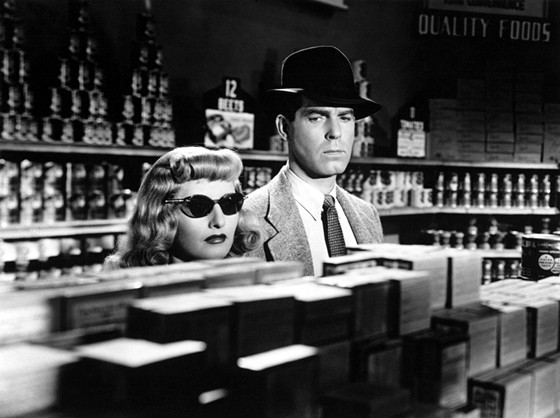
Film noir, flourishing in America throughout the 1940’s and 1950’s, is one of the most disturbing of movie genres – is it, in the first place, a distinct genre at all? Or a subgenre of crime movies, a movement or a visual style – this is still an ongoing debate among film critics and film theorists.
Film noir can be seen as a transition from classical to modern narrative due to their often incoherent, ambiguous plot and the plurality of viewpoints. This obscure world is also reflected visually as well as narratively, by their typical expressionist lighting, by the way the characters are lit and portrayed in the story.
It is no wonder then that these fragmanted, sometimes compliceted plots, weaving together dreams and visions with the also alterable truth, made noir movies perfectly fruitful inspiration source for the 1960’s European new waves and individual movie auteurs.
However, film noir is much more about the heroine and the hero’s investigation about her, than about the actual investigation of the crime.
Femme fatale itself is a character with great diversity, she is in many cases a young unmarried girl, often with at least one suitor who she of course doesn’t care for, and in other cases she is tied to someone in an unhappy marriage who she tries to escape from using the hero as a tool to help her.
She can appear as evil and deceiving, weaving her web around her victim relentlessly or at the other end of the scale, an (almost!) innocent girl lost and deceived herself. It is not her evilness or innocence after all which makes her the femme fatale; whether she does or does not intentionally want the hero to fall, she is inevitably such an influence on him which causes the male protagonist to abandon, even forget his original purpose and eventually causes both of their destruction and/or death.
Even if she seems not to be, she is smart and powerful and controls everything in the background – some of them does this in a smoother way, some of them are more explicitly cruel and ruthless. But in either way, they have remarkable characteristics, they are charming, irresistible, intriguing, unpredictable, dark and dangerous, and top of all, sexually empowered which was not a typical attribute in Hollywood’s former portrayal of women.
They are obsessive and obsessed, most of the time with ideas that were traditionally attributed to men: fame, power, money – and control over their own life, choices and freedom.
They are subversive, typically destructive – and the destruction of their men always leads to their own destruction too. They are nonconformists and do not fit in the typical roles in society and in family and – thus they become dangerous: – do not even want to.
Below, I collected some of the most intriguing femme fatale characters from the greatest pictures of this genre. I only chose to include films where the film in its entirety is great or even now a classic, although my goal was to keep my focus on the femme fatale herself.
I want to dedicate this list to the greatest and most interesting femme fatales, and since there is quite a few of them, I had to leave out some. Kiss Me Deadly (1955) for instance, is one of the most remarkable noirs I have seen and my personal favourite, but has only made it as far as honourable mentions. As a movie it is jawdropping, but as for its femme fatale character, I found that there are more interesting ones. The same goes for a couple of other movies and femme fatales.
Lana Turner as Cora Smith in The Postman Always Rings Twice (1946) from James M. Cain’s novel (which got filmed again under the same title in 1981 with Jessica Lange and Jack Nicholson); Claire Trevor as Velma in Murder, My Sweet (1944) from Raymond Chandler’s novel „Farewell, My Lovely”; and Ava Gardner as Kitty Collins in The Killers (1946).
I tried to choose characters who are not necessarily typical, rather special in one way or other. And because there are so many wonderful femme fatales, this top 10 is not an ultimate list, it is a suggestion for what I see as ten astonishing, well-written, worth-to-see characters. Now let’s see who they are…
10. Sunset Boulevard (1950)
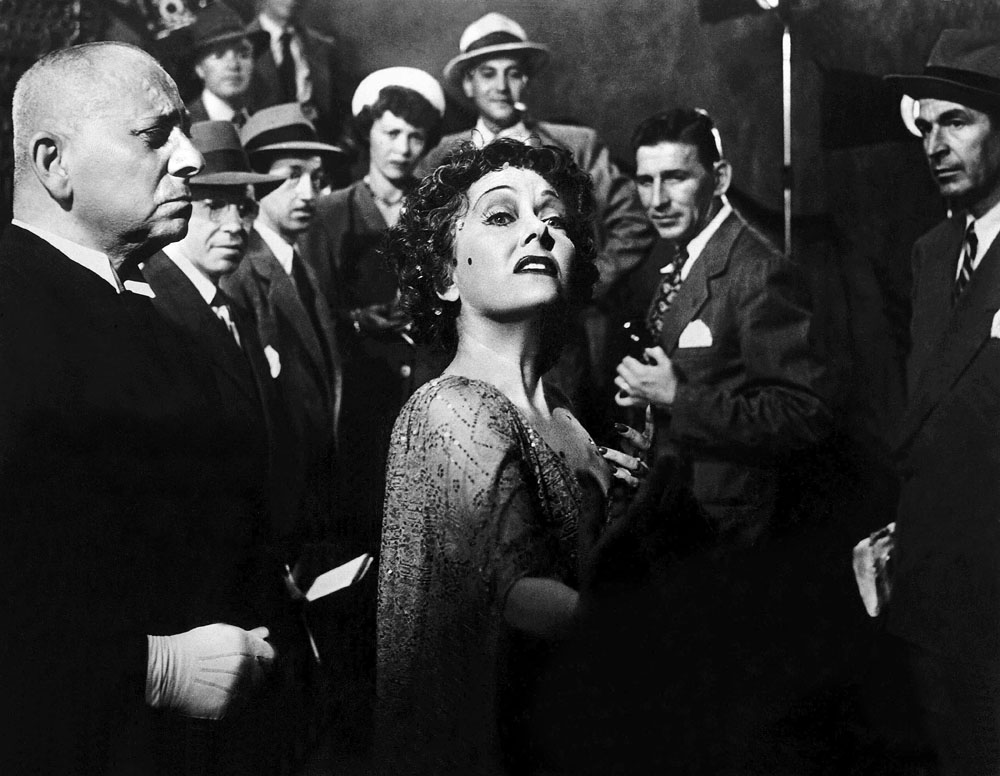
Norma Desmond (Gloria Swanson) is the queen of the silent movie era, now reigning in her beautiful palace, alone. She very much plans her big coming-back though and gets screenwriter Joe Gillis (William Holden) help her.
As Elsa takes the wheel from Michael in The Lady from Shanghai, here Norma takes the lead in driving and even deprive Joe from his car, his last contact to the world outside Norma’s world and his symbol of his own control and manliness.
She is passionate and she knows no such thing as objection. She is a narcissist and a classical, beautifully described spider woman. Her image is presented not only through the plot but very strongly supported visually as well.
Her painted portrait is placed in a central spot in the house and her photos and memories from her movie star years are everywhere, as well as the fake fan letters, delivered faithfully by her ex-husband and butler Max (played by Erich von Stroheim). Everything is arranged around her legend here and everyone is part of the game.
Besides the exciting plot, it is a wonderful hommage to cinema and specifically to the silent movie era as well – with the well-known, symbolical scene at the end of the movie where Norma Desmond walks down the stairs among the dozens of pairs of eyes and the cameras observing her.
9. The Lady from Shanghai (1947)
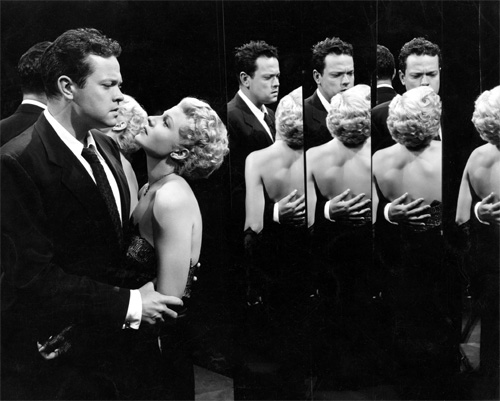
In this cult noir directed by Orson Welles, sailor Michael O’Hara (played by Orson Welles himself) is enchanted by rich and wicked Elsa Bannister (Rita Hayworth). She is the ultimate unpredictable femme fatale who pretends to be naive and innocent but none of these in reality. She claims not to know how to use a gun but on the other hand, tells the story of having lived in the most dangerous and wicked cities of the world.
The scene where she sings a song on the boat in both memorable and expressive. All of the men are turned to salt as they listen, including Michael, Elsa’s husband, Arthur Bannister (Everett Sloane) and George Grisby (Glenn Anders) – both of the latter ones her equals in their attraction for obscure matters and evil deeds.
But not only the men get under the influence of her song, Elsa seems to be pleased with herself too. She is a classical narcissist which of course make men want her even more, but ironically, places her even further away from them. She cannot be possessed or controlled because she is the one who controls – it is very expressive as she takes the steering wheel from Michael once.
And of course their boat is not named Circe by accident. For a reminder, Circe was the woman who kept Odysseus enchanted in her island for years. But as we know, Odysseus broke free eventually.
8. The Strange Love of Martha Ivers (1946)
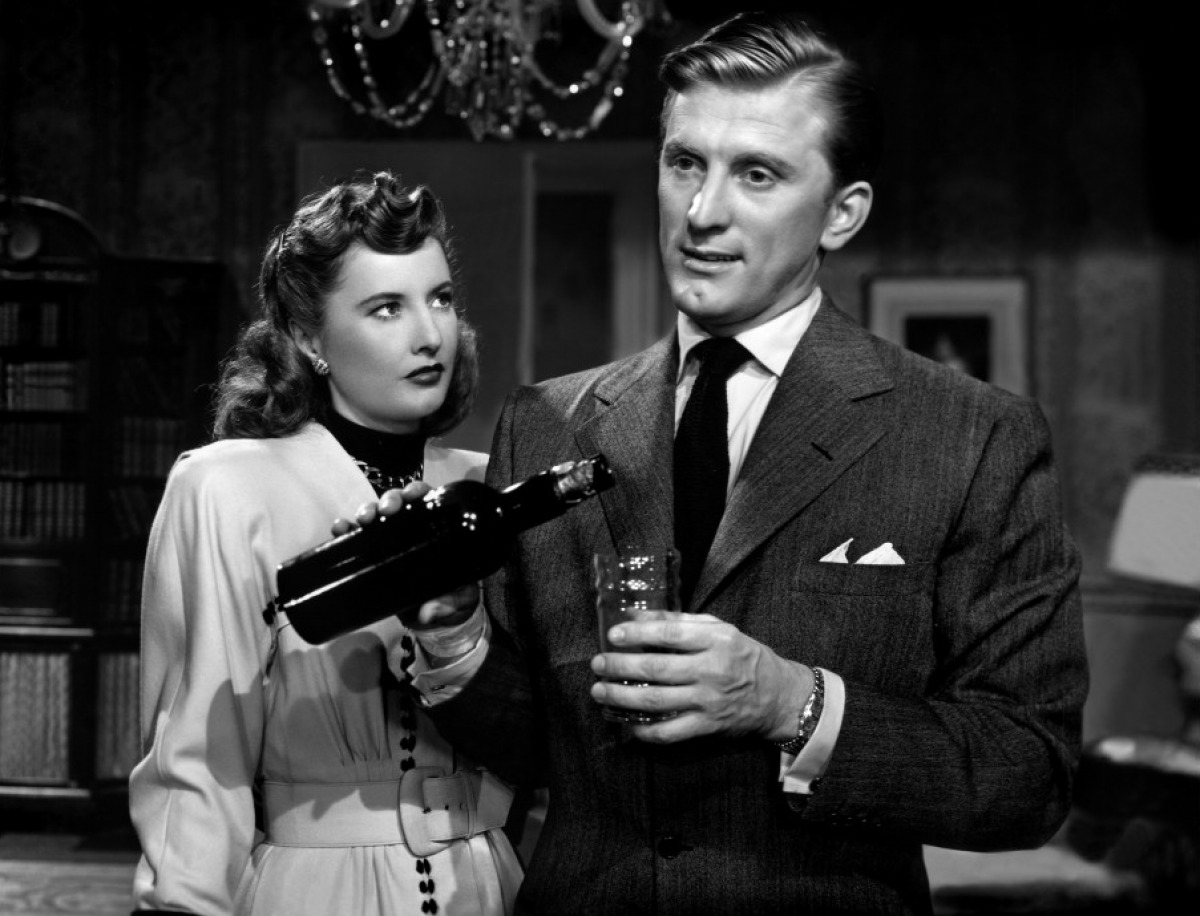
Rarely happens that we get to see or know anything about the femme fatale’s childhood and the misery that turned her to be the person she is. That’s one of the reasons why the story of Martha Ivers (played by Barbara Stanwyck) is so interesting. She is an absolutely complex figure – because her evil deeds are psychologically reasoned and we see where it comes from, her evilness is less convincing, or else to say, more confusing.
We sympathize with her as much as we do with the younger female character (Toni Marachek played by Lizbeth Scott who also plays femme fatale roles in other noirs) who competes for the male protagonist’s heart.
The fact that we can follow her path from childhood, gives us an insight and we are put in the same entangled position that of the male protagonist (Sam Masterson played by Van Heflin) who we see struggling in a love and hate relationship with his childhood sweetheart.
As in many other noirs, the femme fatale is connected here with a deadly bond to her equally wicked husband (Walter O’Neil, played by Kirk Douglas who made his film debut with this movie). They are tied together, alive and dead, by a dark secret and that eventually grows upon them.
7. Out of the Past (1947)
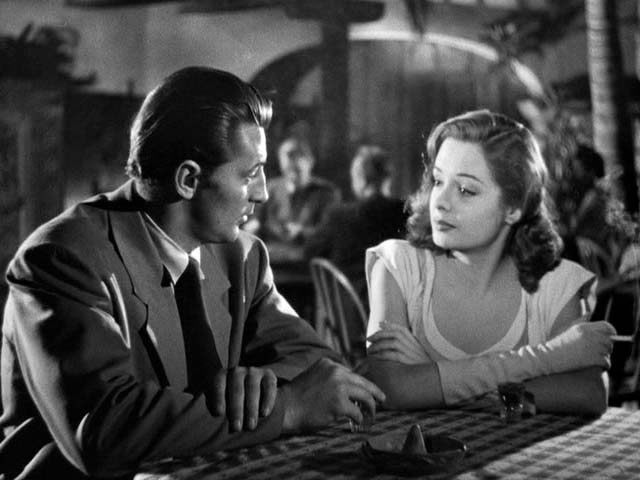
The story about private eye Jeff (Robert Mitchum) and seem-to-be-innocent femme fatale Kathie (Jane Greer) is told through many flashbacks. We see Jeff first trying to start a new life running a gas station and being in a sweet romance with the good-girl Ann (Virginia Houston) who is an absolute opposite of Kathie – who is after all, as it turns out, the main reason he is hiding in a small town.
She appears on screen with big, innocent eyes and dressed completely in white – which, in this case, does not symbolize, rather disguise her true nature.
She has an ultimate power over the men around her, she manages to make Jeff forget what he was supposed to do in the very first minute they meet. This is described perfectly int he scene when talking about the whereabouts of the $ 40.000 Whit (Kirk Douglas) sent him to investigate about, Jeff tells Kathie he is not interested in who has the money („I don’t care, baby”).
From the first moment of meeting her, he is doomed. Until the very end, Jeff tries to make things right, but she has a different plan for him. Even if it leads to her own demise.
6. Gilda (1946)
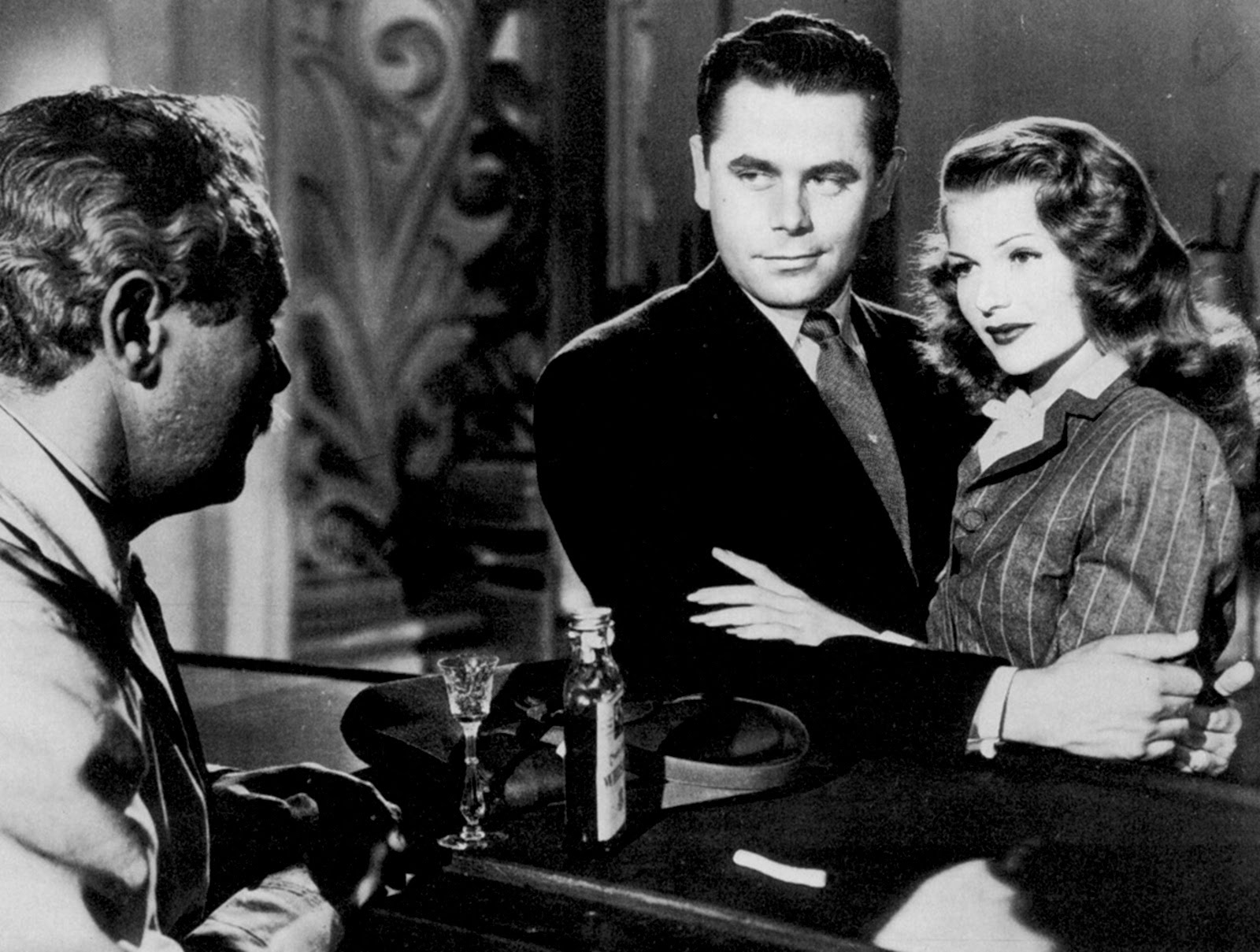
Gilda is a rare combination of romance and film noir which makes the tone of the movie a little less gloomy and a little more heated. It introduces Rita Hayworth in her first dramatic role as the femme fatale. As probably everyone knows, Gilda became her enigmatic role later. Also, there are similarities between her role and her own life as she also started her career as a dancer and there are hints about Gilda’s past life as being a dancer too.
The main plot is simple: Gilda is married to a wealthy casino owner Ballin Mundson (George Macready) for money but is in love with another man, the gambler turned casino manager Johnny Farrell (Glenn Ford). They turn out to have known each other from before although their past life or the reason why they had broken up is never really revealed.
The three form a most peculiar romantic triangle, with so complex love and hate emotions in all directions that one easily gets confused who is jealous of who. And jealousy does not only appear between Gilda and one man or the other, there is also a strange hint about the relationship of the two men – it is just enough to remember how Johnny and Ballin agrees at the beginning of the story there is not going to be a woman in their life.
Gilda as a desperate and lonely femme-fatale-in-love does everything in her power to get Johnny’s love back. And she has power. The movie is filled with her dancing and singing acts, for instance when she performs „Amado Mio” in a club or „Put the Blame on Mame” in the casino with the famous gloves-stripping scene that became her trademark.
The movie is full of classical fairy-tale-like twists that are almost unbelievable in a noir and a few deus ex machina turns, which make everything all right at the end. Thus it is delightful and exciting to watch Gilda among all the much darker and more fatal noirs and to rewatch again and again the now cult classic, enigmatic scenes of Rita Hayworth because – it is a cliché but true – there are not any movies like this any more.